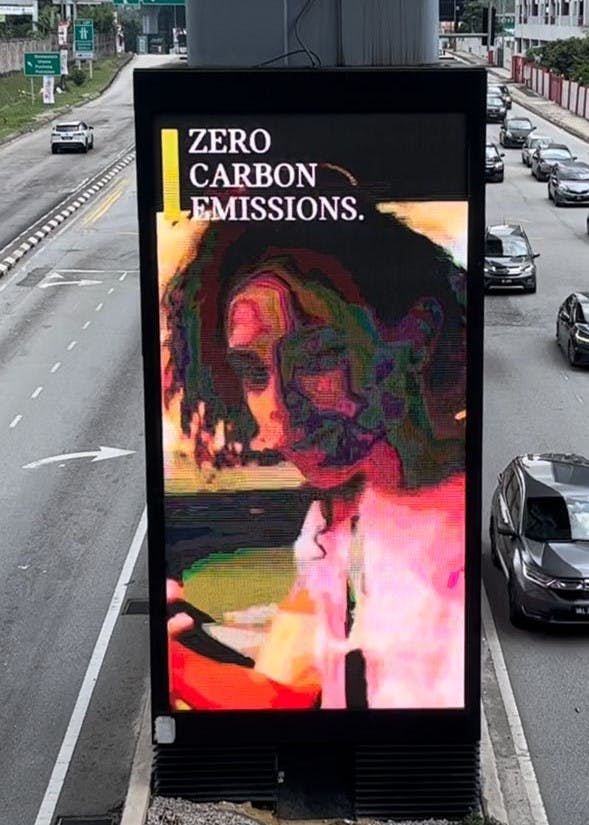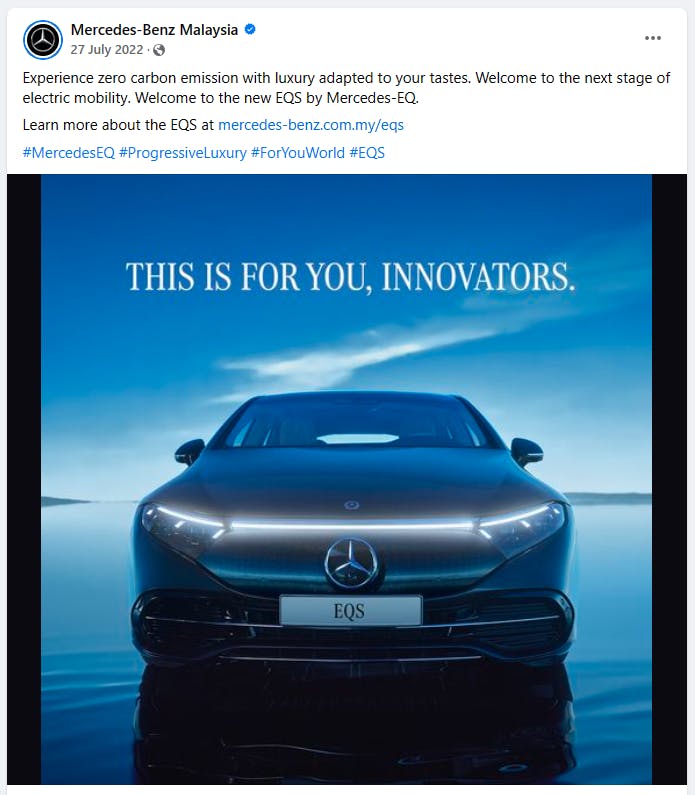In Malaysia, electric vehicles (EVs) have been increasingly touted as a driving force for reducing local transport emissions, but an environmental watchdog is calling for energy sources of EVs to be cleaned up before the cars are marketed as “emissions-free”.
To continue reading, subscribe to Eco‑Business.
There's something for everyone. We offer a range of subscription plans.
- Access our stories and receive our Insights Weekly newsletter with the free EB Member plan.
- Unlock unlimited access to our content and archive with EB Circle.
- Publish your content with EB Premium.
Last month, Malaysia-based non-profit Rimbawatch said in a statement that advertisements for EV sales in Malaysia are rife with greenwashing and could “mislead consumers” into believing that EVs have achieved net-zero emissions even though they continue to rely on a fossil fuel-powered electricity grid.
In particular, Rimbawatch called out four automakers for explicitly advertising their EV models as having zero emissions per kilometre. The models in question are the MINI Cooper SE, BYD Atto 3, the EQ range of Mercedes-Benz cars and BMW’s iX range.
Using the 2021 energy mix for Peninsular Malaysia which comprised 59.2 per cent coal and 34.3 per cent gas as a key reference point, Rimbawatch calculated that the electricity grid’s emissions factor is 0.55 kilogrammes (kg) of carbon dioxide emitted for every kilowatt-hour.
Based on the watchdog’s analysis, the MINI Cooper SE produced some 0.083kg of carbon dioxide per kilometre (CO2/km), while the BYD Atto 3 and Mercedes Benz EQS each produced 0.086kg of CO2/km. The BMW iX1 produced 0.095kg of CO2/km.
In comparison, a petrol-powered Perodua Myvi, which is a popular Malaysian subcompact or B-segment car, emits 0.1 kg of CO2/km, Rimbawatch said.
“Unless EVs are charged from an off-grid and fully renewable source, which is rarely the case in Malaysia, EVs reduce emissions but do not eliminate them,” said Rimbawatch.
Outside of Asia, advertising standards bodies are taking companies to task for exaggerating green claims. Last week, the UK advertising watchdog banned campaigns by carmakers Toyota and Hyundai for overstating the speed at which electric cars can be charged and misleading consumers about the availability of rapid-charging points across the region.
BMW’s website for its iX series states that its EVs have zero “CO2 emissions in g/km (combined)”. This refers to the amount of carbon dioxide emissions produced by the vehicle per kilometre travelled, taking into account both city and highway driving conditions, explained Sashi Ambihaipahan, BMW Group Malaysia’s head of corporate communications and sustainability. The group also distributes MINI Cooper vehicles in Malaysia. The calculation excludes energy-related emissions from the grid for charging the vehicles, as well as energy used along the business value chain.

A digital advertisment for the MINI Cooper SE in Kuala Lumpur touted the vehicle as being emissions-free. Image: Rimbawatch
“We are unable to ascertain the carbon footprint calculation for the electricity used to charge the vehicle beyond the charging point and the vehicle use,” Ambihaipahan told Eco-Business. He added, however, that the BMW Group takes various factors into account to “optimise sustainability in the manufacturing of its EVs”, including consideration of materials, production processes and energy usage.
On their websites, Mercedes and MINI Cooper say that their electric cars have zero local emissions, with MINI adding that “the greenness of any electric car ultimately depends on the source of the electricity that feeds the battery.”
Taking into account the energy used to manufacture the car’s battery pack, internal tests showed that if the MINI Cooper SE is charged using a renewable electricity mix, it would have break even or ‘worked off’ the CO2 released during manufacturing after approximately 19,000 km, the company said.
“Over a full life cycle, the emissions of a MINI Cooper SE are 40 per cent (EU mix) and 70 per cent (renewable mix) compared to that of a petrol-driven MINI Cooper S. Using typical daily driving distances, that means it takes just twelve months of driving for the MINI Cooper SE to offset the extra global warming emissions from producing it,” the automaker said. It also details its material sourcing practices.
BYD Atto 3, produced by Chinese automaker BYD and distributed in Malaysia by Sime Darby Auto, also lists itself as having zero carbon dioxide emissions combined on its website. “The actual energy consumption in real conditions varies depending on the driving style, the nature of the route, the outside temperature, the use of heating and air conditioning and any additional weight,” it said.
At the time of writing, neither Sime Darby Auto nor Cycle and Carriage Bintang, which distributes Mercedes vehicles in Malaysia, had responded to requests for comment.
While RimbaWatch supports greater EV ownership in Malaysia given that the emissions per km of EVs can reduce over their lifetimes, the organisation said that “EVs are not a silver bullet for climate change.”
On top of that, EVs “do not address problematic trends related to traffic congestion, low-ridership of public transport and inaccessible car-centric city design,” said the non-profit.
Rimbawatch added that its analysis had not taken into account the higher emissions related to manufacturing an EV compared to a regular vehicle, and other associated environmental impacts from EV production. “The fact remains that emissions from personal mobility, including both EVs and petrol-fuelled cars, remain a serious issue that is not being sufficiently addressed.”
In 2022, the energy mix of Peninsula Malaysia’s utilities provider, Tenaga Nasional, consisted of 41.8 per cent coal and 34.4 per cent gas. The company’s annual report showed that 4.6 per cent of energy was derived from renewable energy, with the remainder generated via hydropower and oil.
Rimbawatch said that Tenaga Nasiona’s aim of achieving a 35 per cent reduction in emissions by 2035 is unambitious. “High EV-related emissions from the grid will remain for the foreseeable future unless these targets are improved,” it said.

A Facebook advertisment for Mercedes-Benz Malaysia’s EQS series of all-electric cars says users can “experience zero-carbon emissions”, a claim that local watchdog Rimbawatch said is misleading. Image: Mercedes-Benz Malaysia/ Facebook
Powering EVs with solar
The energy mix is not top of mind for Malaysian EV owners, but some have begun fuelling their vehicles using solar installed at home or at their workplaces, said Datuk Dr Abdul Ghaffar Ramli, member of the Malaysian Electric Vehicles Owners Club (MyEVOC).
Ghaffar, who owns an all-electric Renault Zoe, said that the source of electricity of the EV was not his key consideration when he made the purchase. This is because research points to how the operating carbon footprint of Evs are still smaller than ICE cars, with the current energy mix in Malaysia, he explained.
Ghaffar charges his EV with solar-generated power from the panels installed on his home roof, which operate under Malaysia’s Net Energy Metering (NEM) scheme. The scheme enables solar panel owners to sell excess solar energy that they do not use back to the grid operator. Given that his EV has a battery capacity of 22 kilowatt-hours, Ghaffar said that he is generating “more than enough” clean energy for the car as his solar panels produce an average of 28 kilowatt-hours daily.
BMW also currently recommends their dedicated chargers for home use and works with external partners to provide on-the-go charging solutions, although there is no arrangement yet to connect these chargers to clean energy sources.
“We are in conversation with our partners from the energy industry to look into renewable energy sources, but these conversations are only in the beginning stages,” shared Ambihaipahan. He added that customers can connect their chargers to their own renewable power sources “provided they have the necessary equipment and infrastructure in place.”
Malaysia’s ministry of international trade and industry said in February that the country currently has 900 EV charging points and aims to reach 10,000 charging stations by 2025. No mention was been made about the energy source for these charging stations.
“The expansion of EV charging stations should not be emissions-blind,” said Rimbawatch. The priority should be to ensure that EV chargers utilise energy from low-emissions sources, such off-grid solar stations that specifically are for EV charging, it said.










